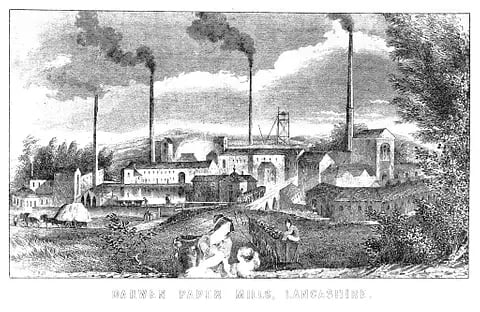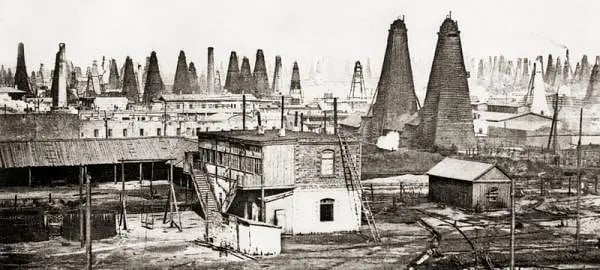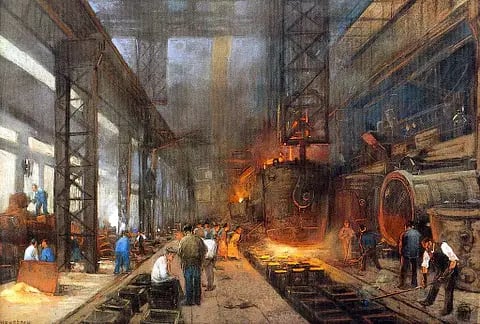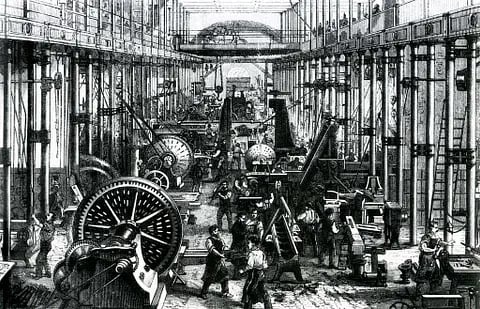Industrial Revolution: How It Transformed the Modern World,
Explore the Industrial Revolution’s innovations, from steam engines to factories, and its impact on society, economy, and the environment. Discover its lasting legacy today.
4/24/2025


The Industrial Revolution: A Comprehensive Encyclopedia of Transformation
Introduction
The Industrial Revolution, spanning roughly from 1760 to 1840, was a pivotal era that transformed human society from agrarian economies to industrialized, urbanized systems. Originating in Britain and spreading to Europe and North America, it introduced groundbreaking technologies like the steam engine, mechanized textile production, and iron manufacturing. This period reshaped economies, social structures, and environments, laying the foundation for the modern world.
This encyclopedia entry provides an in-depth exploration of the Industrial Revolution, covering its origins, key innovations, societal impacts, and lasting legacy. We delve into the factors that sparked this transformation, the technological advancements that drove it, and the profound changes it brought to daily life. By examining its global spread, challenges, and modern relevance, this article offers a comprehensive understanding of an event that continues to shape our lives.
Historical Context
Before the Industrial Revolution, Europe’s economy was predominantly agrarian, with most people living in rural areas and working as farmers or artisans. The feudal system had largely given way to mercantilism, with growing trade networks connecting Europe to Asia, Africa, and the Americas (Britannica: Industrial Revolution). Britain, by the mid-18th century, was primed for change due to its political stability, colonial wealth, and scientific advancements during the Enlightenment.
The Agricultural Revolution (c. 1700–1800) boosted food production through innovations like crop rotation and enclosure, freeing up labor for industry (History.com: Industrial Revolution). Urban populations grew, and cottage industries, particularly in textiles, thrived. However, manual production limited output, setting the stage for mechanization.
Causes of the Industrial Revolution
Why Britain?
Several factors converged to make Britain the birthplace of the Industrial Revolution:
Natural Resources: Abundant coal and iron deposits fueled steam power and machinery (World History Encyclopedia: Industrial Revolution).
Capital and Banking: Wealth from trade and colonies, coupled with a sophisticated banking system, provided investment for industry.
Labor Supply: Population growth and enclosure displaced rural workers, creating a ready workforce for factories.
Political Stability: Unlike revolutionary France, Britain’s stable government encouraged innovation and entrepreneurship.
Scientific and Intellectual Climate: The Enlightenment fostered experimentation, with figures like James Watt refining steam technology.
Debated Origins
While Britain’s advantages are clear, historians debate whether cultural factors, like a “spirit of innovation,” or economic incentives were more critical. Some argue global trade, including profits from the slave trade, played a larger role than previously acknowledged (Wikipedia: Industrial Revolution).
Key Innovations and Technologies
The Industrial Revolution was driven by technological breakthroughs that revolutionized production and transportation.
Textile Industry
Textiles were the first sector to mechanize, transforming Britain into the “workshop of the world.” Key inventions included:
Spinning Jenny (1764): Invented by James Hargreaves, it allowed one worker to spin multiple threads, increasing yarn production (History.com: Spinning Jenny).
Water Frame (1769): Richard Arkwright’s water-powered machine produced stronger threads, enabling factory-based production.
Spinning Mule (1779): Samuel Crompton’s hybrid machine combined the jenny and water frame, producing finer cotton threads.
Power Loom (1785): Edmund Cartwright’s loom automated weaving, though early models were inefficient.
These innovations shifted textile production from homes to factories, with cotton imports from the Americas fueling growth (BBC Bitesize: Industrial Revolution).
Steam Power
The steam engine, refined by James Watt in the 1770s, was the era’s defining technology. Watt’s improvements, including a separate condenser, made engines more efficient, powering factories, mines, and later transportation (Britannica: Steam Engine). By 1800, over 500 Watt engines were in use in Britain.
Iron and Steel
Iron production surged with innovations like Abraham Darby’s use of coke (a coal derivative) to smelt iron, reducing costs. Henry Cort’s puddling process (1784) improved iron quality, enabling stronger machinery and infrastructure (World History Encyclopedia: Industrial Revolution).
Transportation
Canals: By 1800, Britain had over 4,000 miles of canals, transporting goods efficiently (History.com: Industrial Revolution).
Railways: George Stephenson’s Rocket (1829) and the Liverpool-Manchester Railway (1830) revolutionized transport, cutting travel times and costs.
Steamships: By the 1830s, steam-powered ships like the SS Great Western enabled faster transatlantic travel.
Innovation Inventor Year Impact Spinning Jenny James Hargreaves 1764 Multiplied textile output Steam Engine James Watt 1775 Powered factories and transport . Powered factories and Henry Cort 1784 Improved iron quality
transport Locomotive (Rocket) George Stephenson 1829 Launched railway era
Spread of the Industrial Revolution
Europe
The revolution spread to Europe by the early 19th century. Belgium, with coal and iron, industrialized rapidly, followed by France, where government investment in railways spurred growth. Germany lagged until the 1850s but became a powerhouse by 1900 due to its chemical and steel industries (Wikipedia: Industrial Revolution).
North America
In the United States, industrialization began in the 1790s with Samuel Slater’s textile mills in Rhode Island. The Erie Canal (1825) and railroads accelerated growth, with the Northeast leading by 1860 (History.com: Industrial Revolution).
Global Impact
By the late 19th century, Japan and parts of Russia adopted industrial technologies, often with state support. Colonial economies, however, were often exploited for raw materials, delaying their industrialization (World History Encyclopedia: Industrial Revolution).
Societal Impacts
Economic Transformation
The Industrial Revolution boosted economic output, with Britain’s GDP doubling between 1760 and 1830. Factory systems centralized production, increasing efficiency but creating repetitive, low-skill jobs. Global trade expanded, with Britain exporting textiles and machinery (EH.net: Industrial Revolution).
Urbanization
Mass migration to cities led to rapid urban growth. Manchester’s population rose from 25,000 in 1772 to 400,000 by 1850. Cities offered jobs but were overcrowded, with poor sanitation leading to cholera outbreaks (BBC Bitesize: Industrial Revolution).
Working Conditions
Factory workers faced grueling conditions: 12–14-hour shifts, dangerous machinery, and low wages. Children as young as six worked in mines and mills, prompting reforms like the Factory Act of 1833, which limited child labor (History.com: Industrial Revolution).
Social Changes
Class Structure: A new working class emerged, alongside a wealthy industrial middle class. Social mobility increased, but inequality widened.
Gender Roles: Women and children joined the workforce, though often in low-paid roles. Middle-class women were increasingly confined to domestic roles.
Education: Demand for skilled workers led to expanded schooling, though access remained limited for the poor.
Environmental Impact
Coal-powered factories and urban growth caused air and water pollution. Rivers like the Thames became heavily contaminated, and smog plagued cities. Deforestation and resource extraction altered landscapes, foreshadowing modern environmental challenges (World History Encyclopedia: Industrial Revolution).
Responses and Reforms
Labor Movements
Workers formed trade unions to demand better wages and conditions, despite early bans like Britain’s Combination Acts (1799–1800). Strikes and collective bargaining gained traction by the 1830s, laying the groundwork for modern labor rights (BBC Bitesize: Industrial Revolution).
Government Reforms
Factory Acts (1833–1878): Restricted child labor and set workplace safety standards.
Public Health Act (1848): Addressed urban sanitation, establishing local health boards.
Education Acts (1870–1880): Mandated schooling, improving literacy.
Intellectual Responses
The Industrial Revolution sparked ideological debates. Adam Smith’s free-market ideas in The Wealth of Nations (1776) supported industrial capitalism, while Karl Marx and Friedrich Engels criticized its inequalities, advocating socialism in The Communist Manifesto (1848) (Britannica: Industrial Revolution).
Legacy and Modern Relevance
Economic and Technological Legacy
The Industrial Revolution established the factory system, mass production, and global trade networks, shaping modern capitalism. Innovations in steam, iron, and textiles paved the way for advancements in electricity, steel, and computing in the Second Industrial Revolution (c. 1870–1914) (History.com: Industrial Revolution).
Social Legacy
It created the modern working class and urban society, with labor and education reforms improving living standards over time. However, its social costs—child labor, inequality, and urban poverty—sparked ongoing debates about industrial progress (EH.net: Industrial Revolution).
Environmental Lessons
The revolution’s environmental toll informs current sustainability efforts. Policies addressing pollution and resource use draw on lessons from industrial-era challenges, emphasizing the need for green technologies (World History Encyclopedia: Industrial Revolution).
Global Influence
The Industrial Revolution globalized economies, with Western powers dominating trade and colonization. Its uneven spread contributed to global inequalities, a topic still relevant in discussions of development and equity.
Ongoing Debates
Historians debate the revolution’s timeline, causes, and impacts:
Timeline: Some extend its end to 1870, including railways and steel, while others limit it to 1840.
Causes: Was Britain’s lead due to unique resources or broader cultural and economic trends?
Social Impact: Did it improve living standards or exacerbate inequality? Evidence suggests wages rose slowly, but quality of life varied by region and class.
Recent scholarship highlights the role of colonial exploitation, with raw materials and slave labor fueling industrial growth, complicating narratives of “progress” (Wikipedia: Industrial Revolution).
Conclusion
The Industrial Revolution was a transformative era that redefined human society through technological innovation, economic growth, and social change. From the steam engine to urban factories, it laid the foundations of the modern world while introducing challenges like inequality and environmental degradation. Its legacy—economic systems, labor rights, and technological progress—continues to shape our lives, offering lessons for balancing innovation with sustainability. By understanding this pivotal period, we gain insight into the forces that drive progress and the responsibilities that come with it.





